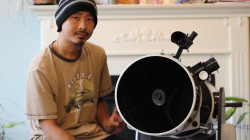Can you use a guide scope as a finder scope? I did. Here are my first impressions of the SVBONY 50 mm guide scope.
While this seems to be a generic guide scope that has sold under different brand names, it doesn’t appear to be cheaply made. This appears to be a good quality product with excellent fit and finish. The rough focussing tube is long enough to reach focus without the need of an extension. The helical focuser was very smooth with no rough grinding feel. When rotating the focuser, it does not rotate whatever is attached at the focuser end. So if you have a camera attached, it will remain in the same orientation instead of twisting any cables that might be attached to it.
When I aligned it during the day, I found the images came through very clearly. The 6 thumb screws took some getting used to for alignment but I was able to align it with precision. I also appreciate how it has nylon tips to prevent scratching the scopes’ nice finish. Finally, the price of this guide scope is so reasonable that I think it offers excellent value for your money.
A few things worth noting are that the trade off for not needing an extension tube to reach focus is that you cannot use a diagonal as an attachment. Also, this did not come with any manual so you would have to figure it out for yourself on how to assemble and install it. I hope this video helped a little bit in that regard. And lastly, the images through the eyepiece appear upside down, but I already expected that. Overall, I think this is a great addition to my astronomy gear.
- SVBony SV106 Guide Scope: https://amzn.to/303lUey
- SVBony Dovetail Base: https://amzn.to/3oEjrkP









